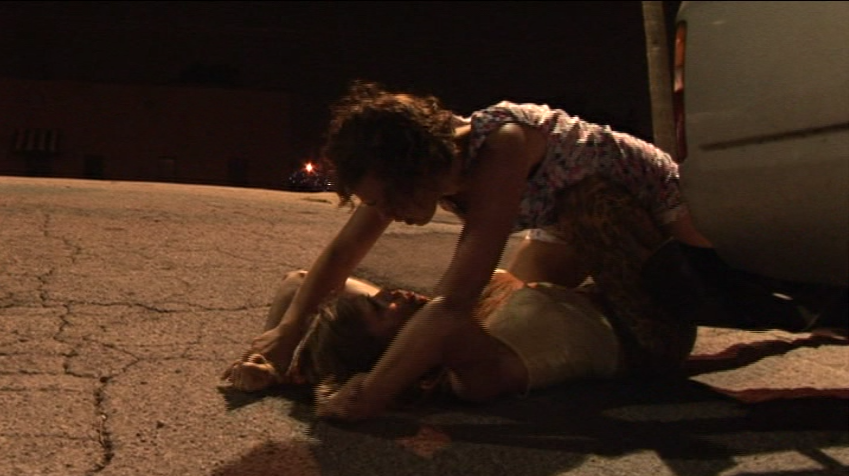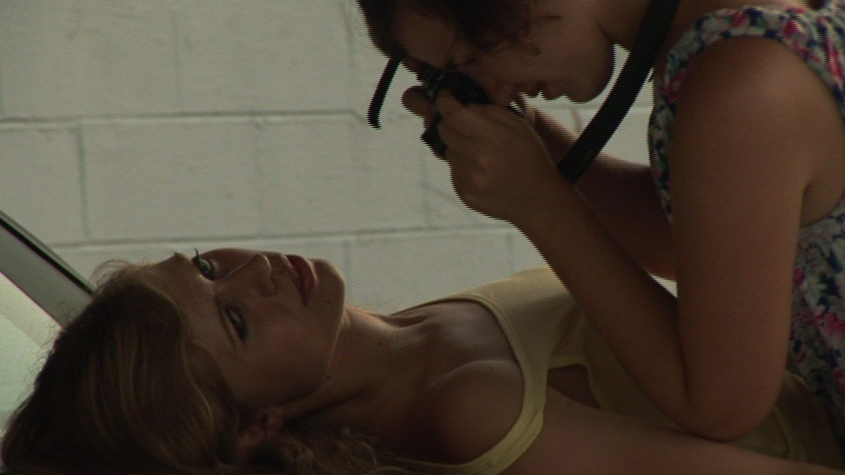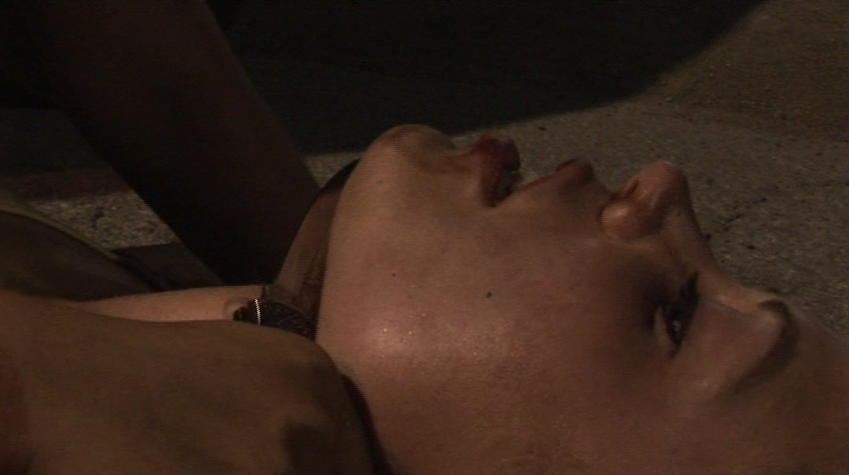The Prop Gets Bigger
Jae Matthews
Two young women wrestle in the bed of a pickup truck. It’s the middle of the night, and in the far distance fireworks light up the sky. It’s hot—their bodies glisten and the image on screen is unmistakably lascivious. The two girls cry and grunt; one bears a knife, carelessly swinging it about, almost stabbing her best friend. The violence of the form exists in uncomfortable tension with the unstable sexuality that buds below the surface.
Laurel Nakadate’s The Wolf Knife (2010) acknowledges how vital mise-en-scène design is for conveying the ulterior motives of narrative film. The film’s namesake is a prop that appears only twice, yet it proves fundamental to the film’s deeper themes. The film plays with representation, using various elements of mise-en-scène to confront the audience with their problematic role as spectators who begin to recognize their own complicity in a violent, sexualizing gaze. The knife – both as literal prop and as eponymous symbol – allows the film to accomplish this effect, as it demonstrates the young women’s inability to express a sexual agency that is not tainted by violence.
On its narrative surface, the film is simple: two young women (Chrissy and June), detached from their troubled home-lives, bored with the pool days of Florida, decide to go on a road-trip. The girls are BFFs: they dress in the same skin-tight leggings and tank tops, they drink the same huge sodas, and neither is in control of her sexual agency. Their gestures and banter regularly teeter on the brink of sexual expression, but their desires remain unknown, even, it seems, to themselves.
Yet when Chrissy, the more dominant and precocious girl, discovers the “wolf knife,” her personality changes. The knife (with a wolf’s head carved into its handle) is introduced almost an hour into the film—it is found by Chrissy in the bathroom at the seedy motel where the two girls are staying. In the scene preceding the discovery, June, the sweeter and more naïve girl, admits to sleeping with Chrissy’s stepfather’s son (an “off limits” sexual conquest to Chrissy, because of the closeness of their relation). Chrissy is hurt and jealous of June’s sexual encounter. Their friendship is marked by an ambiguous competition and envy—Do they want what the other has? Do they want one another? Do they want to actually be the other? They covet one another’s body and form, yet they lack the capacity to possess one another. When Chrissy discovers the knife and wields it, she becomes aggressive and brutish to her best friend, waking her up by throwing items at her in bed, and pushing her roughly into a car to take a photo. Although we see only one close-up shot of the knife at this point, the shift it perpetuates in Chrissy is striking. She is now able to dominate her best friend and possess her own sexual prowess.
The Wolf Knife bears the name of this prop because it appears during the most climactic moment of an otherwise loose and wandering film. When the knife appears, our two leads have reached the end of everything—the proverbial road (they are stationed in a parking lot), and the patient, gentle space of friendship. Their relationship by this point is drained by sexual innuendo, jealousy, and confusion. June tries to flee, but Chrissy pins her down and threatens her with the knife. The knife represents Chrissy’s power over her friend, a power she learns from regular rape-like scenarios she has suffered through in her past, without question. Her budding sexuality is tainted by the world that surrounds her—a world that insists that sexuality is expressed only through wielding phallic power over another… it requires a victim. The wolf knife embodies this world of violence and eroticism that paves the way for female adolescence.
As Mary Gaitskill remarked about The Wolf Knife, “sex and damage do get mixed up, vigorously.”1 This uncomfortable mixing exists as a baseline hum throughout the film, but bursts violently through the surface in the scenes that feature the wolf knife. The young women in the film appear to be piloted by a destructive, carnal force that somehow materializes in the wolf knife. The prop becomes bigger, because it suggests symbolic tendencies of its own: whenever it appears, the codes become crossed and our two young leads incarnate active, desiring personas, who impose their fantasies upon one another. The wolf knife embodies the confused world of violence and eroticism, providing a phallic and violent means to express the masculine, predatory sexuality that dominates the young women’s world.
Jae Matthews is a filmmaker living in Savannah, GA. Her work has been featured in FUCKYOUDRACULAS Videozine, Non-Fiction Experimental Slumber Party and Savannah Alternative Media Showcase. She is currently pursuing a dual MFA in Film Production and Cinema Studies at the Savannah College of Art and Design.
_________________
1 Mary Gaitskill. “Beg for your life: In the well with Laurel Nakadate.” SF360 1 (2011): 1-3.



